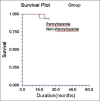Pancytopenia - (?) An obstacle in the diagnosis and outcome of pediatric acute lymphoblastic leukemia
- PMID: 25992344
- PMCID: PMC4418085
- DOI: 10.4103/2278-330X.155648
Pancytopenia - (?) An obstacle in the diagnosis and outcome of pediatric acute lymphoblastic leukemia
Abstract
Context: Acute lymphoblastic leukemia (ALL) ranks first among pediatric malignancies. 8-12% of ALL present with pancytopenia and 2% with hypocellular marrow a. Diagnosis of ALL in the background of pancytopenia and aplastic bone marrow is difficult.
Aims: This study was aimed to compare the clinicopathologic, genetic, and outcome of paediatric ALL patients with and without pancytopenia.
Settings and design: This is a retrospective cross-sectional study.
Subjects and methods: The study included all ALL patients presenting with pancytopenia. The control group included equal number of randomly selected patients with ALL without pancytopenia treated during the same period. Ethics committee approved this study. The demographic, laboratory, and treatment-related details were retrieved from the records and entered in an Excel sheet.
Statistical analysis used: Data was analyzed with Chi-square test with IBM SPSS statistics 16 software.
Results: Diagnosis by peripheral smear is significantly lower (P = 0.015) in comparison with the control group. There is no significant difference in diagnosis between the groups by bone marrow aspirate (P = 0.731) and biopsy (P = 0.849). The diagnosis of leukemia is misdiagnosed as hypo cellular/aplastic marrow in 10% of the pancytopenic patients. Flow cytometry yielded the diagnosis in all the pancytopenic patients. Though cytogenetic abnormalities are more common in pancytopenic group, it is not statistically significant (P = 0.106). There is no significant difference in treatment outcome between the groups (P = 0.0827%).
Conclusions: Clinical expertise is highly essential to evaluate a case of pancytopenia to diagnose leukemia. Pancytopenia is an obstacle in the diagnosis of ALL without immunophenotyping. There is no significant difference in the outcome between the two groups.
Keywords: Acute lymphoblastic leukemia; flow cytometry; pancytopenia; pediatric acute lymphoblastic leukemia.
Conflict of interest statement
References
-
- Arora RS, Eden TO, Kapoor G. Epidemiology of childhood cancer in India. Indian J Cancer. 2009;46:264–73. - PubMed
-
- Breatnach F, Chessells JM, Greaves MF. The aplastic presentation of childhood leukaemia: A feature of common-ALL. Br J Haematol. 1981;49:387–93. - PubMed
-
- Kelly K, Murphy P. Aplastic anaemia preceding acute lymphoblastic leukaemia in an adult with isolated deletion of chromosome 9q. Leuk Res. 2008;32:1936–8. - PubMed
-
- Melhorn DK, Gross S, Newman AJ. Acute childhood leukemia presenting as aplastic anemia: The response to corticosteroids. J Pediatr. 1970;77:647–52. - PubMed
-
- Matloub YH, Brunning RD, Arthur DC, Ramsay NK. Severe aplastic anemia preceding acute lymphoblastic leukemia. Cancer. 1993;71:264–8. - PubMed
LinkOut - more resources
Full Text Sources
Medical


